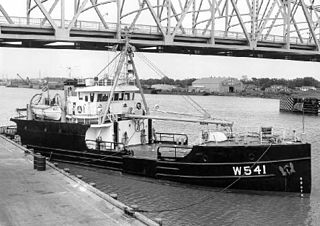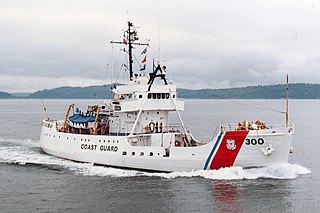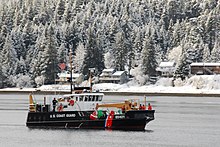
USCGC Mesquite (WAGL/WLB-305) was the lead ship in the Mesquite class of seagoing buoy tenders operated by the United States Coast Guard. She served in the Pacific during World War II, and spent the rest of her Coast Guard career in the Great Lakes. She ran aground and was wrecked in December 1989 off the Keweenaw Peninsula in Lake Superior. She was scuttled nearby as a recreational diving attraction.

USCGC Balsam (WLB-62) was a Cactus-class seagoing buoy tender (WLB) in the United States Coast Guard. She operated in the Pacific Ocean during World War II, then saw service along the United States West Coast, Hawaii, and Alaska. After her decommissioning in 1975, she was repurposed as a crab catcher-processor and is active in Alaskan fisheries as F/V Baranof.

USCGC Spar (WLB-206) is a United States Coast Guard Juniper-class seagoing buoy tender home-ported in Duluth, Minnesota. The ship maintains aids to navigation in the Twin Ports and Great Lakes.

USCGC Maple (WLB-207) is a Juniper-class seagoing buoy tender operated by the United States Coast Guard. She was based at Sitka, Alaska for 16 years and is currently homeported at Atlantic Beach, North Carolina. Her primary mission is maintaining aids to navigation, but she also supports search and rescue, law enforcement, oil spill response, and other Coast Guard missions.
There are two classes of USCG Inland Buoy Tenders.

The USCGC White Alder (WLM/WAGL-541) was the former Navy lighter, YF-417. The United States Coast Guard acquired a total of eight of these former Navy YF-257-class lighters between 1947-1948 for conversion to coastal buoy tenders. They were needed to complement the larger seagoing buoy tenders in servicing short-range-aids-to-navigation, typically those placed in coastal waters and harbors.

USCGC Juniper (WLB-201) is the lead ship of the U.S. Coast Guard's current class of seagoing buoy tenders. She is outfitted with some of the most advanced technological and navigational capabilities currently available.

USCGC Citrus (WAGL-300/WLB-300/WMEC-300) was a Cactus (A)-class seagoing buoy tender built in 1942 in Duluth, Minnesota, and now operated by the navy of the Dominican Republic.

USCGC Elm (WLB-204) is a U.S. Coast Guard Juniper-class seagoing buoy tender home-ported in Astoria, Oregon. She is responsible for maintaining aids to navigation on the coasts of Oregon and Washington, including the Columbia River.

USCGC Anacapa (WPB-1335) is a decommissioned Island-class cutter of the United States Coast Guard. She was based at Petersburg, Alaska and Port Angeles, Washington and was responsible for law enforcement, search and rescue, and maritime defense.

USCGC Aspen (WLB-208) is the eighth cutter in the Juniper-class 225 ft (69 m) of seagoing buoy tenders. She is under the operational control of the Commander of the Seventeenth U.S. Coast Guard District and is home-ported in Homer, Alaska. Her primary responsibility areas are Kachemak Bay of Cook Inlet to the Kuskokwim River in southwest Alaska and the high seas off south-central and southwest Alaska. Aspen conducts heavy lift aids-to-navigation operations, and law enforcement, homeland security, environmental pollution response, and search and rescue as directed.

USCGC Bluebell (WLI-313) is a United States Coast Guard inland buoy tender based out of Portland, Oregon.

The USCGC Walnut (WLM-252) was a steel-hulled, steam-powered twin-screw Hollyhock-class tender built for the Lighthouse Service in 1939 at Oakland, California. With the transfer of the Lighthouse Service to the Coast Guard in June, 1939, she was commissioned as a Coast Guard cutter on 8 July 1939.

USCGC Elm(WAGL-260/WLI-72260) was an inland buoy tender used maintain aids to navigation by the United States Coast Guard.

USCGC Ironwood (WAGL-297/WLB-297) is a former Mesquite-class sea-going buoy tender operated by the United States Coast Guard. She served in World War II, the Korean War, and the Vietnam War as well as a variety of domestic missions. She currently serves as a seamanship training vessel for Job Corps.

USCGC Planetree (WAGL/WLB-307) was a Mesquite-class seagoing buoy tender operated by the United States Coast Guard. She served during World War II, the Korean War, and the Vietnam War, as well as in a variety of domestic missions.

The USCGC Sweetbrier (WAGL-405/WLB-405) was an Iris-class 180-foot seagoing buoy tender operated by the United States Coast Guard. She served in the Pacific during World War II. Her entire post-war career with the Coast Guard was spent in Alaska. After she was decommissioned in 2001, she was transferred to the Ghana Navy and renamed Bonsu. She is still active.

USCGC Barberry (WLI-294) is a United States Coast Guard buoy tender that was donated to the state of Maryland in 1971. Based out of two locations in North Carolina and then Portsmouth, Virginia, during her Coast Guard career, the vessel was then used as an icebreaker by the Maryland Department of Natural Resources. In 2020, the Maryland Department of Natural Resources announced that the vessel would be replaced; her replacement is expected to be commissioned in 2022.

USCGC Red Oak (WLM-689) was a Red-class coastal buoy tender designed, built, owned, and operated by the United States Coast Guard. She was launched in 1971 and homeported at Gloucester City, New Jersey until Coast Guard Base Gloucester was closed in 1988. For the remainder of her career she was home-ported in Philadelphia. Her primary mission was maintaining over 300 aids to navigation in the upper Cheasapeake Bay and its tributaries including the Delaware, North East, Chester, Bohemia, Sassafras, and Susquehanna Rivers, and the C&D Canal. She was also responsible for refueling the Brandywine Shoal lighthouse. Her secondary missions included search and rescue, light icebreaking, law enforcement, and marine environmental protection. Red Oak was initially assigned to the 3rd Coast Guard District, but was later moved to the 5th Coast Guard District when the 3rd was absorbed in a reorganization.

USCGC Red Birch (WLM-687) is a Red-class coastal buoy tender that was designed, built, owned, and operated by the United States Coast Guard. She was launched in 1965 and initially homeported at San Francisco. Her primary mission was maintaining 160 aids to navigation in San Francisco, San Pablo, and Suisun Bays, and in the San Joaquin River. Red Birch also brought supplies to the Farallon Island lighthouse. In 1976 the Coast Guard reassigned her to Baltimore, Maryland, where she spent the rest of her career. There she maintained over 300 aids to navigation including several lighthouses. Her secondary missions included search and rescue, light icebreaking, law enforcement, and marine environmental protection.




















